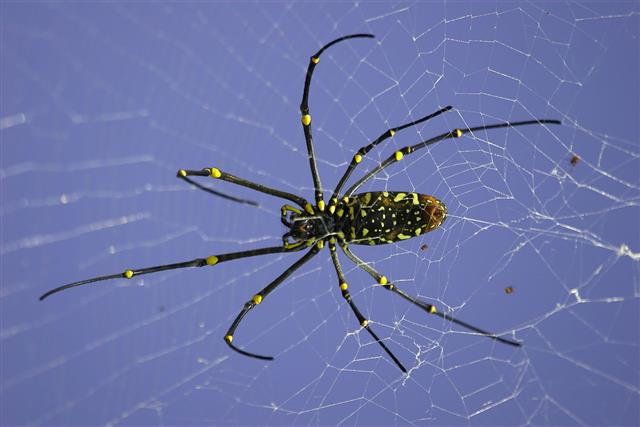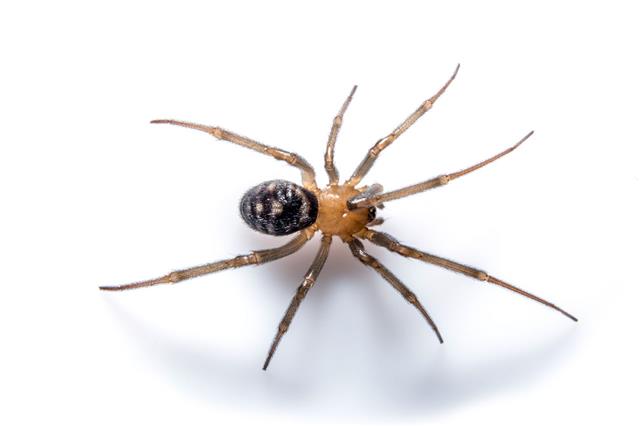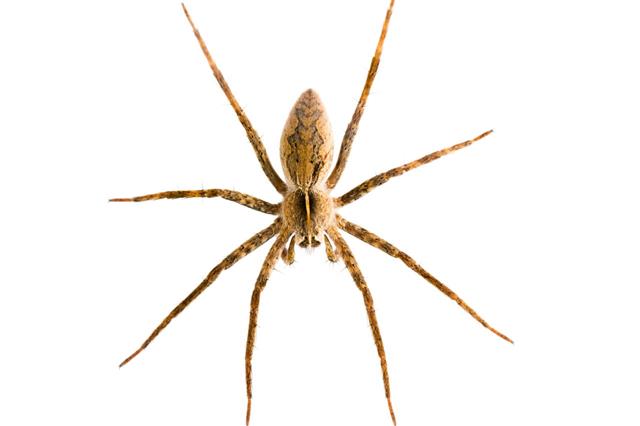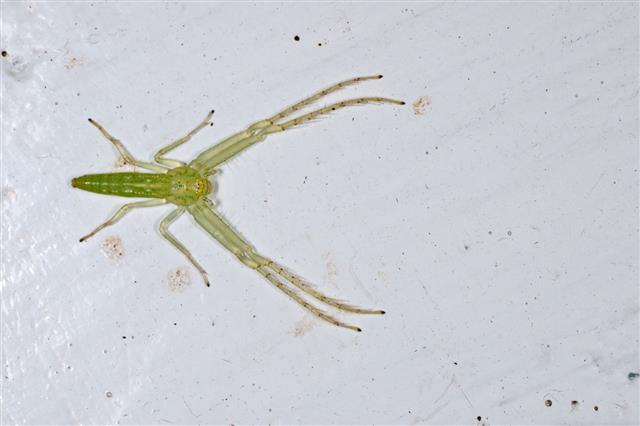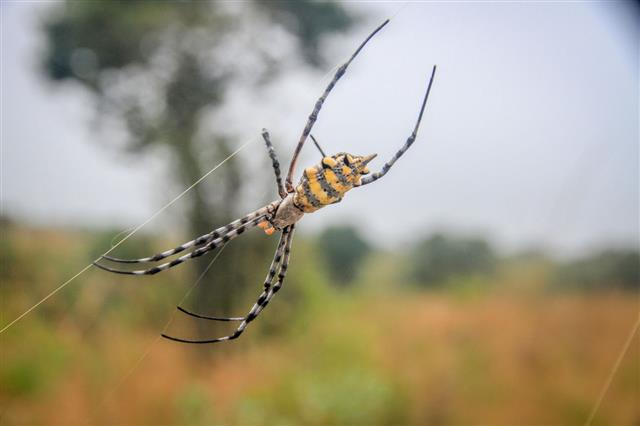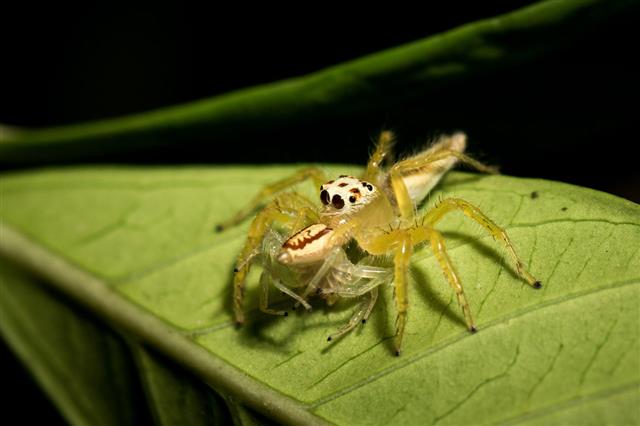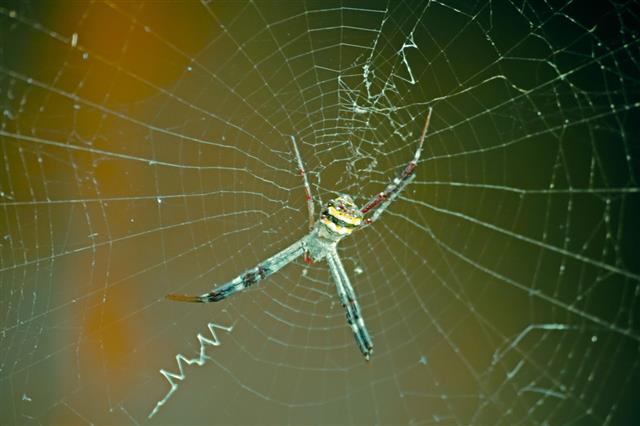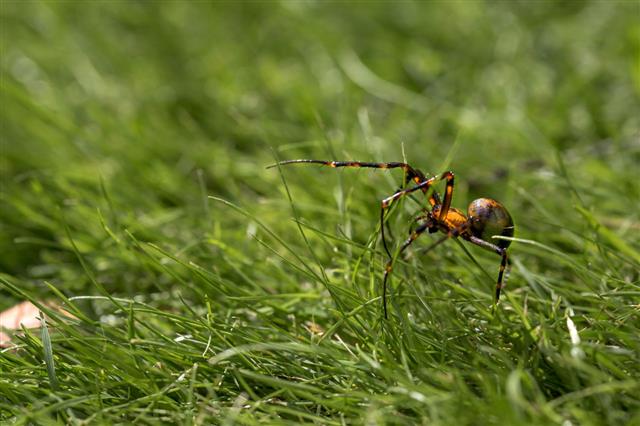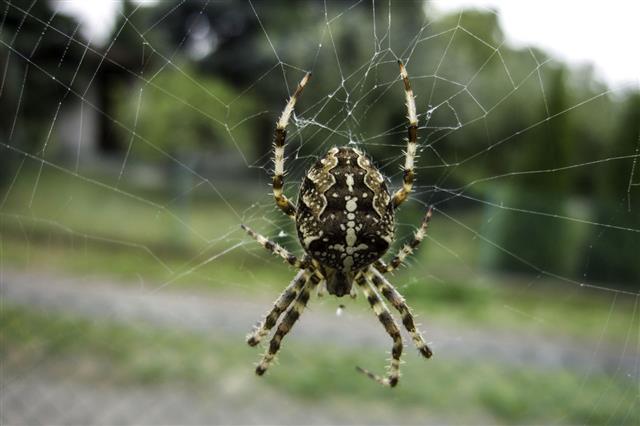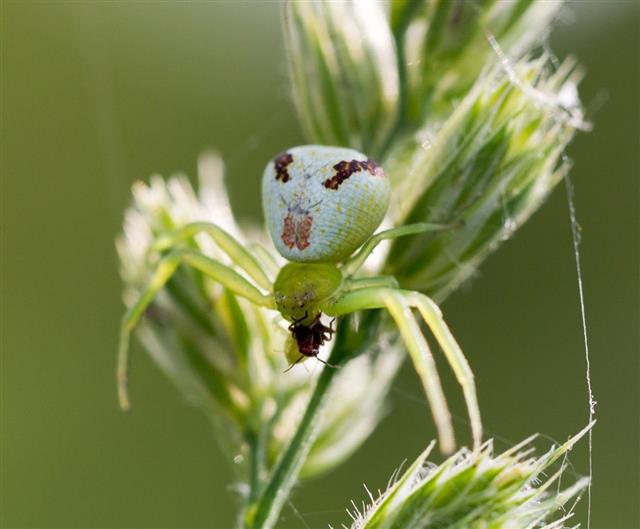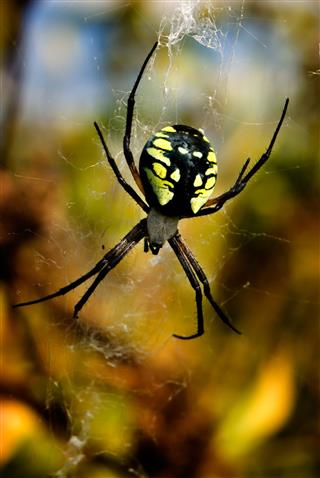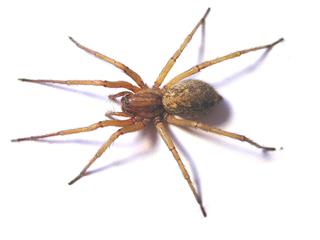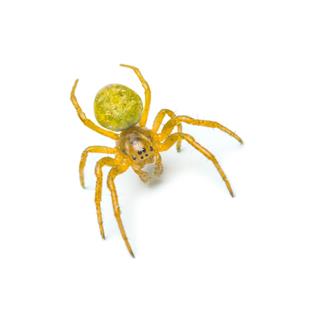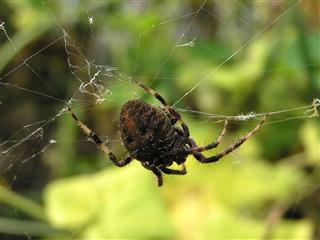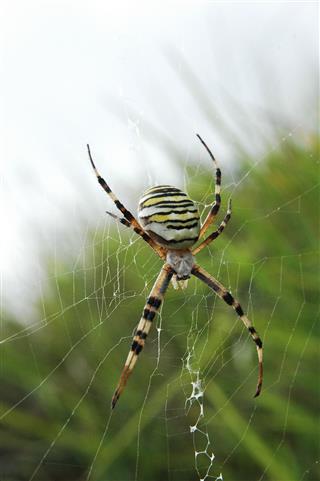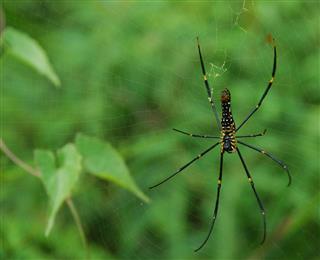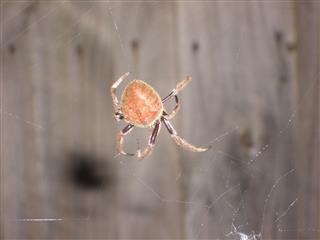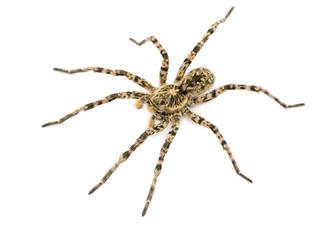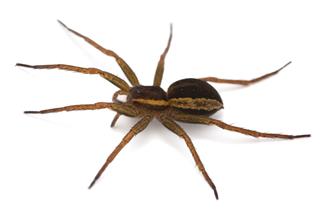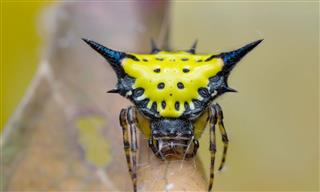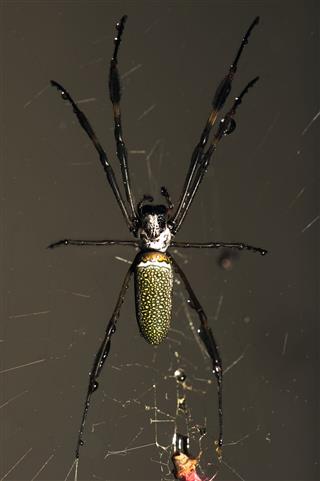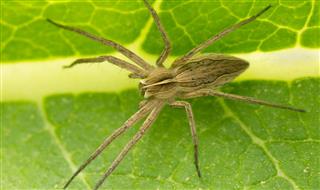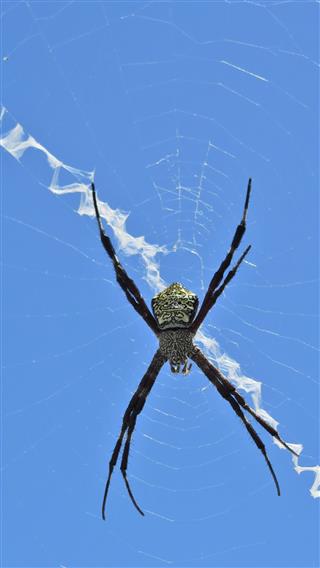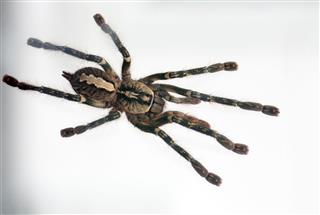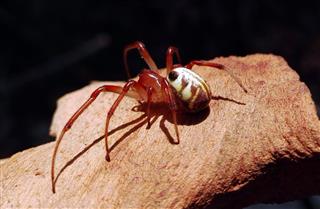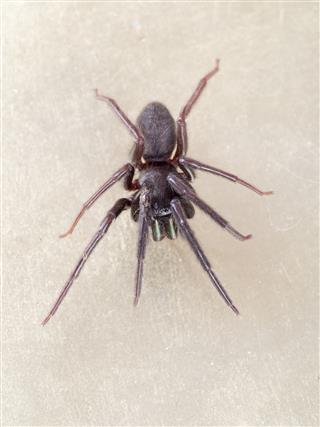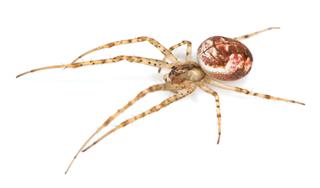
Spiders are omnipresent, and this is because of their unusual ability to transport themselves by just releasing a strand of silk and letting the wind just carry them. This write-up gives information about a few of the different species of spiders present in Georgia.
Acoustic Webs!
Spiders can tune the silk fibers of their webs, which when plucked produce vibrations of different frequencies. This tells the spider of the presence of its prey or any structural damage to the web.
Spiders are terrestrial arthropods with eight legs that are present in all continents except Antarctica. They have the seventh largest diversity. There are about 42,000 species of spiders present worldwide; America alone has about 3,807 species of spiders recorded till the year 2012. Some spiders possess venom either for self defense or for catching its prey. But the most striking fact about spiders that has fascinated scientists for decades is their highly elastic, but extremely strong spider silk that they produce, which is used for catching its prey, laying eggs, and building its retreat.
The body of spiders is made of a head that is fused to the thorax, thus called the cephalothorax, and abdomen. Appendages in spiders is joint, which is why they belong to the phylum of arthropods. The tip of the legs, called tarsus, usually has claws that help the spider to walk on its web. The spider’s body is covered by an outer skeleton of chitin and possesses fangs; therefore, it belongs to the class of arachnids. There are a total of 111 families of spiders that have been recorded till date.
Taxonomic Classification of Spiders
● Kingdom: Animalia
● Phylum: Arthropoda
● Class: Arachnida
● Order: Araneae
The humid and subtropical conditions of Georgia make it ideal for the survival of various insects, and that’s why many species of spiders can be found here. Georgia houses more than twenty species of spiders, some which are given below.







Classifying Spiders According to Behavior
• Diurnal
• Nocturnal
• Fishing
• Spitting
• Venomous
• Others
Diurnal Spiders
1. Argiope aurantia
● Family: Aranneidae
● Genus: Argiope
● Species: Argiope aurantia
● Common name: Black and yellow garden spiders/Golden orb weaver/Garden Spider
● Habitat: Fields, gardens, or forests
● Activity: Diurnal
Females are usually larger than males. The average size of females is about 14-28 mm, whereas males are about 5-8 mm excluding their legs. This spider has a total of eight eyes that are arranged in pairs. A pair of median eyes are present centrally, and three pairs of smaller eyes are arranged around it. Legs are long as compared to the body, and the tips of the legs have three claws. The first two pairs of legs are directed forward and the hind two pairs are directed in the backward direction. These individuals show sexual dimorphism. Females have a rounded abdomen that is usually black in color with bright yellow patterns. Their carapace is usually silvery white in color. Males are not very colorful, found usually in shades of brown. These are usually annual species and the male usually dies after mating.
2. Argiope trifasciata
● Family: Aranneidae
● Genus: Argiope
● Species: Argiope trifasciata
● Common name: Banded garden spider/ Garden spiders
● Habitat: Fields, gardens or forests
● Activity: Diurnal
The average size of females is about 10-25 mm, whereas males ar about 4-6 mm (legs excluded). This spider has a total of eight eyes that are arranged in pairs. A pair of median eyes are present centrally and three pairs of smaller eyes are arranged around it. Legs are long as compared to the body, and the tips of the legs have three claws. The abdomen of these individuals is rounded towards the cephalothorax and more pointed on the rear side. Female abdomens are yellow or white in color with black transverse lines, whereas male abdomens are silvery white in color with hues of gold. Carapaces of both sexes are white or silver in color. They prey on small insects that get trapped in their web. Again, these too are annual species and the males die after mating.
3. Micrathena sagittata
● Family: Aranidae
● Genus: Micrathena
● Species: Micrathena sagittata
● Common name: Arrow spider, Arrowhead orb weaver
● Habitat: Deciduous forests
● Activity: Diurnal
Average size of the females is around 8-10 mm and males are around 4-6 mm. They have eight eyes, two pairs of median eyes that are close together, and lateral eyes that are placed far apart. Legs are in proportion to the body and are dark red in color. The tarsus is with 3 claws each. Abdomen is wide at the rear side, and possesses a pair of dark red spines. Abdomen is usually bright yellow in color and the cephalothorax is dark red with two bright yellow lateral lines on the side. Males are usually black in color.
4. Misumena vatia
● Family: Thomisidae
● Genus: Misumena
● Species: Misumena vatia
● Common name: Goldenrod crab spider, Flower crab
● Habitat: On flowers of goldenrod or milkweed
● Activity: Diurnal
Females are usually 6-10 mm in size whereas, males are 3-4 mm. They have eight eyes that are arranged in two rows. The lower row of eyes is slightly curved. Legs are in proportion to the body. The first two pairs of legs are longer. In males, the first two pairs are brown and the hind two pairs of legs are yellow in color. Each tarsus has two claws. In females, the posterior end of the abdomen is usually wider. The abdomen is somewhat triangular in shape. They are usually creamish in color with two magenta or reddish bands running laterally on the sides of the abdomen. Males are more slender, and the lateral bands are somewhat reduced. These spider usually prey on pollinators. Sometimes, they consume pollen.
5. Salticus scenicus
● Family: Salticidae
● Genus: Salticus
●Species: Salticus scenicus
● Common name: Zebra spider/ Zebra jumper
● Habitat: Man-made
● Activity: Diurnal
Males and females are almost of the same size with the females being slightly larger, about 4-7 mm. They have eight eyes, two of which are located posteriorly on the carapace and the median eyes are larger. Legs are short and thick with bands of tan and black. Each tarsus has 2 claws. The body is black in color with golden highlights. Males have large jaws with fangs called chelicerae. Males are darker and more slender than females.
Nocturnal Spiders
6.Tegenaria domestica
● Family: Agelenidae
● Genus: Tegenaria
● Species: Tegenaria domestica
● Common name: Barn funnel weaver/ Domestic house spider
● Habitat: Man-made
● Activity: Nocturnal
Females are larger than males. The average size of a female is about 6-12 mm, and the male measures between 6-9 mm. They have eight pair of eyes that are arranged in two rows. The bottom row is straight and the top row is slightly curved upwards. The legs are long in comparison to the body and usually have bands of tan and black. The tarsus is usually with three claws each. The abdomen and the cephalothorax are usually of the same size. In females, the abdomen is more round as compared to males. The cephalothorax is pear-shaped; it is light brown in color with two dark brown lines running laterally on the thorax. The abdomen is grayish in color with brown crisscross patterns. The web of these individuals is in the shape of a funnel.
7. Cheiracanthium mildei
● Family: Eutichuridae
● Genus: Cheiracanthium
● Species: Cheiracanthium mildei
● Common name: Long legged sac spider/ Yellow sac spider
● Habitat: Man-made
● Activity: Nocturnal
The average size of a female is 7-10 mm, whereas males are usually 5-9 mm. Eyes are usually eight in number that are arranged in two rows, the upper row being more curved. Legs are in proportion to the body with two claws on each tarsus. The cephalothorax and the abdomen are almost equal in size. Body is widest in the middle and tapering towards both the ends. They prey on small insects and are usually found near outdoor lights.
8. Dysdera crocata
● Family: Dysderidae
● Genus: Dysdera
● Species: Dysdera crocata
● Common name: Woodlouse hunter
● Habitat: Garden/ Field/ Forest
● Activity: Nocturnal
The average size of these spiders excluding legs is about 12-16 mm in females and 8-10 mm in males. These individuals have six eyes instead that are arranged close together in a semicircle. The legs are proportionate to the body and are bright orange in color with 2 claws on each tarsus. The abdomen and cephalothorax are almost equal in size. The cephalothorax is yellowish brown in color, whereas the abdomen is yellowish brown or gray in color. These individuals possess a large jaw with fangs that are called chelicerae. These individuals primarily prey on woodlice but feed on any other prey that they can catch.
9. Herpyllus ecclesiasticus
● Family: Gnaphosidae
● Genus: Herpyllus
● Species: Herpyllus ecclesiasticus
● Common name: Eastern Parson spider/ Ground spider
● Habitat: Under tree barks/ Old debris
● Activity: Nocturnal
The average size of a female is 6.5-12 mm, whereas males usually measure between 4.5-6.5 mm. These individuals have eight eyes that are arranged in two rows with the median eyes being larger than the rest of the eyes. The legs are brownish black with the hind two pairs being the longest. Each tarsus is with two claws. The cephalothorax and abdomen are almost equal in size and slender. They are blackish brown in color and the abdomen bears silvery white stripes. These individuals feed on insects that they can catch and may be that’s why they are usually found near outdoor lights.
10. Kukulcania hibernalis
● Family: Filistatidae
● Genus: Kukulcania
● Species: Kukulcania hibernalis
● Common name: Southern house spider/ Crevice weaver
● Habitat: Man-made
● Activity: Nocturnal
Females are usually larger than males. The average size of females is about 10-25 mm, whereas males are about 9-12 mm (legs excluded). The eight eyes are arranged in a cluster close together. Legs are usually proportionate to the body having with three claws. These individuals show sexual dimorphism; females are grayish black or dark brown in color. Males are light brown in color and are often mistaken for brown recluses. Males are usually more slender than females.
Fishing Spiders
11. Dolomedes triton
● Family: Pisauridae
● Genus: Dolomedes
● Species: Dolomedes triton
● Common name: Six spotted fishing spider/ fishing spider/ raft spider
● Habitat: Margins of water bodies
● Activity: Diurnal
The average body size of females is 15-20 mm and the males measure 9-13 mm. They have eight eyes that are arranged in two slightly curved rows with the two pairs of median eyes being slightly bigger than the lateral eyes. Legs are proportionate to the body. Each tarsus has three claws. The abdomen and the cephalothorax are of the same size. The abdomen is more rounded towards the thorax. It is dark brown in color with a pair of white spots. The cephalothorax is dark brown with white stripes. The sternum has six black spots, hence the name. These individuals are capable of walking on water and can remain underwater for 30-60 minutes. They usually prey on insects and small fish.
12. Dolomedes tenebrosus
● Family: Pisauridae
● Genus: Dolomedes
● Species: Dolomedes tenebrosus
● Common name: Raft spider/ Dark fishing spider
● Habitat: Margins of water bodies
● Activity: Nocturnal
The average body size of females is 15-20 mm while the males measure 7-13 mm. They have two pairs of eyes that are arranged in two slightly curved rows with the two pairs of median eyes being slightly bigger than the lateral eyes. Legs are proportionate to the body and have black and brown bands. Each tarsus has three claws. The abdomen and the cephalothorax are of the same size. The abdomen is more rounded towards the thorax. It usually gray in color with characteristic three ‘W’ shaped markings. They usually prey on insects and small fish like minnow. These, however, are not as well-adapted to the aquatic habitat as other fishing spiders. The males are usually killed after mating. The females carry their eggs in their jaws (chelicerae) before laying them in a web.
Spitting Spiders
13. Peucetia viridans
● Family: Oxyopidae
● Genus: Peucetia
● Species: Peucetia viridans
● Common name: Green lynx spider/ Green lynx/ Lynx spider
● Habitat: Herbaceous gardens/ Dessert conditions
● Activity: Diurnal
These females are about 11-22 mm in size, and the males are about 8-15 mm. They have eight eyes that are arranged in an elliptical manner with two eyes on the lower side being very small and two lateral eyes being larger; the other eyes are somewhat oval in shape. Legs are long and thin usually longer in males. Legs are green with conspicuous black spines. The cephalothorax is pear-shaped and bright green. The abdomen is rounded towards the thorax and tapers to a point in the rear end. The abdomen too is bright green in color with two reddish or deep magenta lines running laterally on two sides of the abdomen. It feeds on other insects and spiders, and its diet mostly comprises honeybees. These spiders are capable of spitting venom when attacked as an act of self-defense.
14. Scytodes thoracica
● Family: Scytodidae
● Genus: Scytodes
● Species: Scytodes thoracica
● Common name: Spitting spider/Ornate spitting spider
● Habitat: Man-made
● Activity: Nocturnal
Females on an average measure 4-6 mm, whereas males measure 3-5 mm. They have six eyes that are arranged in three pairs. Legs are in proportion to the body and have bands of tan and brown. Each tarsus has three claws. The abdomen and the cephalothorax are of the same size. The cephalothorax and abdomen are rounded. The body of this spider is somewhat arched due to the arrangement of the cephalothorax and abdomen. There is a pair of venom glands between the cephalothorax and abdomen. The spit contains a mixture of venom and glue, which when in contact with the prey contracts and immobilizes the prey. Here, the spider uses its venom to hunt down its prey.
Venomous Spiders
15. Hogna carolinensis
● Family: Lycosidae
● Genus: Hogna
● Species: Hogna carolinensis
● Common name: Carolina wolf spider/ Wolf spider
● Habitat: Arid regions and Grasslands
● Activity: Nocturnal
These are comparatively larger spiders, with the females measuring about 22-35 mm and the males measuring about 18-20 mm. They have eight eyes that are arranged in three rows. The lower row has four small eyes, while the middle row has two large median eyes. Also, there are two lateral eyes far apart from each other arranged posteriorly. Legs are long usually, longer in males. Every tarsus has three claws. The cephalothorax and the abdomen are of the same size. The body is grayish brown in color. The abdomen usually has a long black mark called the cardiac line. The chelicerae is bright orange in color. The venom possessed by these spiders is not lethal, but can cause allergic reactions in sensitive individuals. The bite may be painful with reddening of the skin. In rare cases, there may be onset of mild fever.
16. Latrodectus geometricus
● Family: Theridiidae
● Genus: Latrodectus
● Species: Latrodectus geometricus
● Common name: Brown widow spider/ Geometric button spider
● Habitat: Man-made (usually in gardens)
● Activity: Diurnal
The average size of females is about 7-10 mm, whereas males are about 2-3 mm. They have eight eyes that are arranged in two rows with the lateral eyes being far apart. Legs of these individuals are long as compared to the body and are with light brown bands. Each tarsus has three claws. The abdomen of females bulges more. It is light brown in color with black and orange spots, and with transverse white stripes that are discontinued in the center. The carapace is dark brown in color. Both males and females have an orange hourglass on the underside of the abdomen. Large amount of the venom can lethal. However, a spider bite injects such little amount of venom that it is harmless. The bite may be painful and leave a mark.
17. Latrodectus mactans
● Family: Theridiidae
● Genus: Latrodectus
● Species: Latrodectus mactans
● Common name: Southern black widow/ black widow/ Hourglass spider
● Habitat: Man-made
● Activity: Nocturnal
Females are much bigger than males. Males are 3-6 mm in size, whereas females are 8-13 mm in size. They have eight eyes that are arranged in two rows. The lateral eyes are separated far apart. The legs are very long, and the third pair of legs are usually the shortest. Females have black legs, whereas the legs have black and brown bands in males. Legs are usually with three claws. The abdomen in females is bulging, whereas it is slender in males. The body is jet black and waxy to look at. The underside of the abdomen possesses a bright red hourglass in both sexes. This spider feeds on other insects and small animals like toad. The venom of this spider is highly potent and is a neurotoxin (affects the nervous system). When the toxin enters the bloodstream, it can cause nausea, headache, vomiting, abdominal pain, elevated blood pressure, and fever.
18. Loxosceles reclusa
● Family: Sicaridae
● Genus: Loxosceles
● Species: Loxosceles reclusa
● Common name: Brown recluse/ Brown fiddler/Violin spider/Fiddleback spider
● Habitat: Man-made
● Activity: Nocturnal
These spider measure usually between 7-12 mm; females are around 9 mm and males are around 8 mm. They have six eyes arranged in pairs of three. Legs are proportionate to the body; the second pair is the longest and the third pair is the shortest. Each tarsus has two claws. The body is light brown in color. The abdomen is oval in shape and the cephalothorax is somewhat flattened and pear-shaped. The carapace has a dark spot that looks like a violin. The venom can be fatal in large amounts. In a smaller amount, its effect can be reddening, and it can sometimes cause tissue necrosis. In rare cases, it affects the vascular system and can be lethal. These individuals feed on insects and other spiders that they can prey upon.
Other Spiders
19. Castianeira longipalpa
● Family: Corinidae
● Genus: Castianeira
● Species: Castianeira longipalpa
● Common name: Ant mimic spider
● Habitat: Close to ground, usually under rocks or old logs of wood
In spiders, the females are usually larger than males, and these females have an average size of 7-10 mm, while males range from 5.5 – 6 mm. They have eight eyes that are arranged in two rows that are slightly curved towards the top. Legs are relatively proportionate to the body size with the hind legs being the longest. Each tarsus is with two claws. Legs are usually black in color with white or reddish bands. The abdomen is usually elongated and slender. It is blackish brown in color with white and occasionally red transverse lines on it. The carapace is blackish brown, somewhat pear-shaped, and is usually covered with white or golden hair. These individuals look a little like ants and tend to mimic the walk of ants.
20. Leucauge venusta
● Family: Tetragnathidae
● Genus: Leucauge
● Species: Leucauge venusta
● Common name: Orchard orb weaver
● Habitat: Gardens and moist places
Females measure 3.5-8 mm on an average, whereas males are about 3.5-4 mm. These individuals have eight eyes arranged in pairs, with the median eyes being larger and close together, and the lateral eyes being far apart. The first two pairs of legs are the longest, whereas the third pair is the shortest. Each tarsus has three claws. The carapace is usually greenish yellow with thin, dark green stripes. The abdomen is elongated and more rounded towards the cephalothorax. The abdomen is usually projecting above the thorax. The abdomen is usually brightly colored, usually metallic green in color, with bright yellow and orange markings. The underside of abdomen has orange spots. These individuals usually feed on insects that get caught in their web.
Although they are widely spread, little is known about them, and the more we learn about them, the more fascinating they seem to be!
